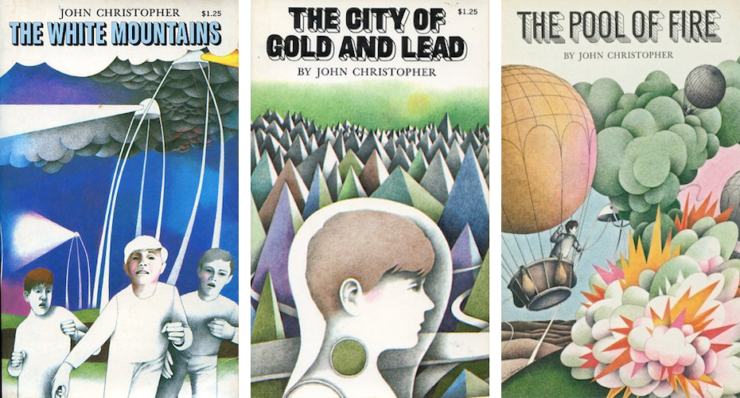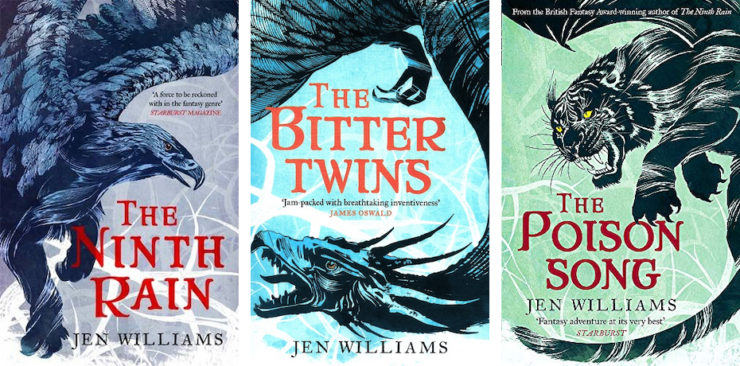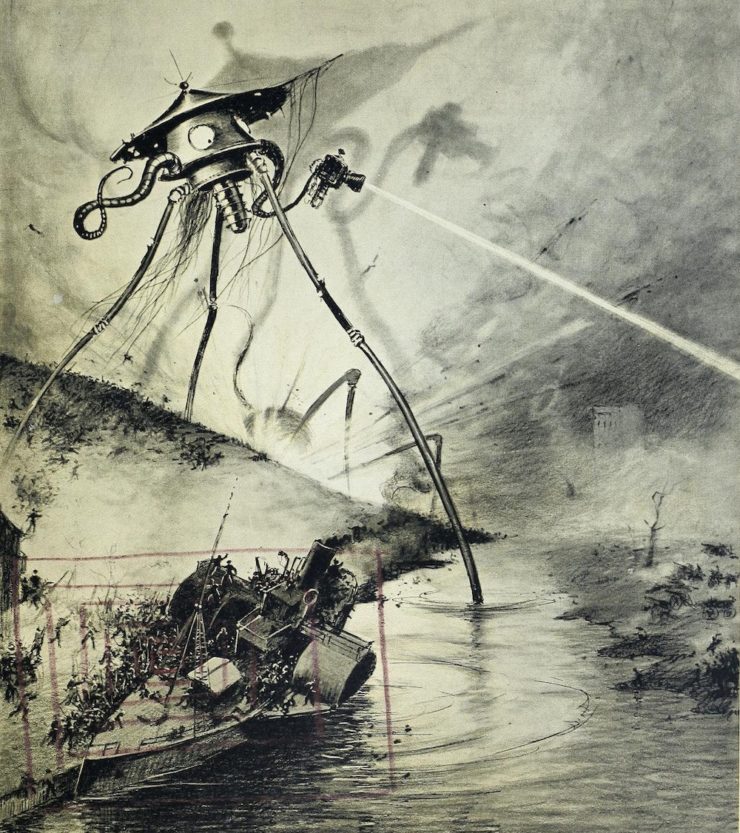The term “terraforming” was first used in Jack Williamson’s 1941 story “Collision Orbit.” As you know, Bob, terraforming is the process of transforming an environment hostile to Terrestrial life into a habitable environment. Humans have been doing this in a minor way for millennia, even before they started domesticating plants. But what we’re talking about here is going from “you die outside the dome” to “you can go outside, breathe the air, and plant a garden.”
Sapients from other worlds might also want to reshape other planets to suit their needs and tastes. Call it “xenoforming.” Perhaps they might want to xenoform our planet. There’s no guarantee that what suits us would suit them… and considerable dramatic potential if it does not, particularly if the aliens have better tech than we do. H.G. Wells was an early pioneer of this conceit in his The War of the Worlds—the Red Weed pushes aside terrestrial plants, at least for a time—but he is hardly the only author to use the idea. Consider these five works about hostile xenoforming.
The Tripods Trilogy: The White Mountains (1967), The City of Gold and Lead (1968), and The Pool of Fire (1968) by John Christopher

Will Parker is born and raised in an orderly world, where young people grow to adulthood and are Capped, transforming them into docile, well-behaved adults fit to serve Earth’s rulers. Said rulers are not other humans but rather the Masters, unseen aliens who govern Earth from their great strongholds. Given that Capping is a form of lobotomy, it is just as well that Will and his chums escape Capping and turn rebel, joining the miniscule resistance against humanity’s overlords.
After infiltrating one of the Masters’ strongholds in The City of Gold and Lead, Will discovers that the situation is far more serious than the resistance thought. The Masters huddle within their cities because they cannot breathe terrestrial air. The aliens have both the ability and the intention to xenoform the Earth, a side effect of which would be the total extinction of the human race (well, a few might be saved as zoo exhibits). The Masters must be stopped if humanity is to be saved…but if humanity at its height fell before the aliens, what hope is there for the rebels?
***
The War Against the Chtorr series: A Matter for Men (1983), A Day for Damnation (1985), A Rage for Revenge (1989), A Season for Slaughter (1993) by David Gerrold

Military and political defeats followed by humiliating concessions to America’s enemies have shaken the United States. Distraction would be welcome, if only distraction did not come in the form of deadly plagues (that kill two-thirds of the human population) and voracious alien lifeforms (that attack the survivors).
Earth is under attack. Its native species seem incapable of withstanding the aggressive interlopers.1 Protagonist Jim McCarthy joined America’s elite military forces almost by accident, but having survived—thus far—he is determined to do his bit to convince Earth’s enemies to abandon their plan to reshape Earth. Alas, the first step in changing an invader’s mind is establishing communication…and the architects of the invasion have not yet revealed themselves.
***
The Interior Life by Dorothy Heydt (as by Katherine Blake) (1990)

Post-Reagan Era housewife Sue leads an unrewarding life. Her energetic children make cleaning a never-ending task. She does love her husband Fred, but there are also the days she cannot stand him (particularly when work problems follow him home). It’s completely understandable that Sue would want to escape into a fantasy world. But it is less clear why Sue keeps returning to the world she inhabits as Lady Amalia, as Lady Amalia’s troubles are so much greater than Sue’s.
It’s not clear if this fantasy world is real or imaginary. What is obvious is that the Dark is inexorably spreading across Lady Amalia’s world, displacing familiar plants and animals with…other things. If this continues unchecked, the world about which Sue daydreams will become Dark and alien. Odd that this process mirrors challenges in Sue’s own life.
***
All You Need Is Kill by Hiroshi Sakurazaka (Trans. Alexander O. Smith) (2004)

The aliens who dispatched the engineered lifeforms humans call Mimics did stop to consider the morality of xenoforming a world that might well be inhabited. But they concluded that xenoforming would be as ethically neutral as killing insects to make way for housing construction. No need to examine Earth before reshaping it.
Keiji Kiriya, human, thinks human needs are more important than alien schemes. Thus, his brief, glorious career in Earth’s defence forces. Thus his inevitable death the first time he encounters Mimics. His resurrection in the past—on the morning before the first battle—comes as an unexpected surprise. Alas, the results of the rerun battle are little better than the first. The same is true of the second. And the third…but by death 157, Keiji is getting the hang of the time loop in which he is trapped and well on his way to figuring out how he might save the Earth for humans.
***
Winnowing Flame Trilogy: The Ninth Rain (2017), The Bitter Twins (2018), The Poison Song (2019) by Jen Williams

Eight times the Jure’lia have invaded Sarn; eight times they have been driven off by the Eborans. What they have left behind: tracts of poisoned lands haunted by malevolent spirits. This would be the fate of the whole world should the Jure’lia ever succeed. Regrettably for Sarn, the Eboran tree-god Ygseril died during the Eighth Rain. Without Ygseril, the Eborans have dwindled into a sad remnant of their former selves. If there is a Ninth Rain, the Eborans will not be able to save their land and their world.
Lady Vincenza “Vintage” de Grazon is determined to replace semidivine warriors with something far more powerful: science! She and her Eboran companion Tormalin the Oathless seek out Jure’lia relics to better understand the invader and why it behaves as it does. Perhaps Vintage will uncover a relic that, once disassembled and understood, will allow the scientist to save her world from the invaders. Or perhaps she and Tormalin will simply get eaten by a nightmarish predator.
***
Of course, Wells and the five authors above are hardly the only authors to explore xenoforming as a plot device. Feel free to visit the comments below and list all the other works I could have cited.
In the words of Wikipedia editor TexasAndroid, prolific book reviewer and perennial Darwin Award nominee James Davis Nicoll is of “questionable notability.” His work has appeared in Publishers Weekly and Romantic Times as well as on his own websites, James Nicoll Reviewsand the Aurora finalist Young People Read Old SFF (where he is assisted by editor Karen Lofstrom and web person Adrienne L. Travis). He is a four-time finalist for the Best Fan Writer Hugo Award and is surprisingly flammable.
[1]Does it make sense to say one world’s ecosystem is more or less advanced than another’s? Have fun discussing this in the comments!











You mentioned the first two to come to my mind (the Tripods and the Chtorr). There’s also the Nitrogen Fix, but the transform of Earth’s atmosphere into a NO-dominated one is purely natural – ask any alien
What are the aliens in John Wyndham’s Out of the Deeps/The Kraken Wakes trying to do? That is a superb alien invasion story that has never gotten the love its deserves.
I really love when I see something on this site like a reference to the Tripod Trilogy and realize I read it and enjoyed it. Probably multiple decades ago.
Not a book, but a TV series (and later a film), Quatermass II involves an alien plan to xenoform Earth to something more pleasing to their palette.
Seconding the love for Wyndham’s The Kraken Wakes. A favourite of mine since childhood.
Ah, Quatermass. The fellow who announced that his rocket experiment had been a success before admitting the crew had (mostly) died.
In Marko Kloos’s Frontlines books, the aliens called the Lankys take over and quickly terraform (xenoform?) the Earth colonies they find in a manner inconsistent with terrestrial life. They remain hoping to do the same to Earth but have not been successful.
The Chlorans in E.E. “Doc” Smith’s Skylark books?
Tom Disch’s first novel, The Genocides, takes place on an Earth that has already been xenoformed as a farm for the immense Plants that they (presumably) use for food or something, with humans struggling to survive at their roots. It’s a very bleak book but funny in a dark way. In other words, it’s Disch.
See also “War with the Newts” by Karel Capek (1936), with “aliens” here being a newly-discovered sentient race on Earth. The “newts” are amphibious humanoids, who begin destroying landmasses to create more aquatic “living space” for themselves, while the land-based human nations are too busy squabbling over their own interests to work together to stop the newts. As is apparent, much of the novel is a satiric commentary on the politics of the time.
This happened semi-accidentally in Robotech; the Second Robotech War (a.k.a. The Masters Saga) ended with Earth being seeded by an alien plant called the Flower of Life (which the Masters had been cultivating as a power source; it was released into the atmosphere when their starship was… involuntarily disassembled).
A few years later, the Invid (who exist symbiotically with the Flower) invaded the now-defenseless Earth (which was already unrecognizable thanks to two apocalyptic wars and an invasive alien plant) and further xenoformed it by building hives and farms and conducting open-air experiments in guided evolution. Humans weren’t fully exterminated only because the few post-apocalyptic/pre-industrial villages that escaped destruction are beneath the new landlords’ notice –unless they start raiding Invid orchards or acquiring directed-energy weapons, as rag-tag resistance fighters are wont to do.
re: your “advanced ecosystem” footnote
I’m pretty sure it’s much like the “more evolved” trope, which is a misunderstanding of evolution as ascending a predetermined ladder. Species adapt to the opportunities and challenges of their environment, though some species are better at adapting to a wider range of conditions more quickly than others. What’s more “advanced”: Alligators that haven’t had to evolve much in 8 million years or pepper moths that turned black after Britain began burning coal in the 1800s?
I’m pretty sure Lovecraft’s Colour Out of Space would qualify, as would its photographic negative/spiritual successor, the Southern Reach trilogy.
Ah, the Chtorr series. Yes, as James alludes in the footnote, the first book’s protagonists, who are supposed to include actual scientists, posit that the invading species are successful at overcoming Earth’s ecosystems because they have had more time to evolve and thus are better competitors. As I recall, no one ever disavows this despite it being most emphatically Not How This Works as regards evolution. Nor do they adopt the obvious theory that the invading lifeforms are successful because they’re engineered. (And as long as I’m at it, let me also complain about the third? fourth? book’s framing device, in which the protagonists are in a course/seminar/training which Gerrold loudly disavows is based on E.S.T. Maybe it isn’t; I don’t think E.S.T.’s head games were so contrived or dumb.)
The series was fun to read, but over time the enjoyment gave way to irritation. Sort of like a real-time experience of having old favorite books visited by the Suck Fairy.
Ian Mc Donald’s Chaga and its sequels?
In Brian Stableford’s The Walking Shadow, Earth is eventually taken over by “third phase” life, which is inimical to any other form of life… the galactic plague mentioned in his The Omega Expedition seems to be the same kind of thing, and I actually think I can see the first glimmerings of the idea, way back near the start of Stableford’s career, in the constantly-changing lifeforms in Halcyon Drift. You read an author for long enough, you start to recognize their themes.
Gryphon, by Crawford Kilian, features a malevolent race tring to reshape the entire galaxy. Thank goodness they ran into the plucky human race!
Jack Williamson’s second-last novel Terraforming Earth. Alien life is trying to terraform earth. A bunch of plucky clones try to prevent this over the course of thousands of years.
In one volume of the Terry Pratchett/Stephen Baxter Long Earth series, one of the series of parallel Earths has its rotation sped up by aliens to the point where it flies apart, in order to provide material for a Dyson sphere in our solar system.
In Wesley Chu’s Lives of Tao trilogy, (and the in-the-same-universe Io duology) semi-gaseous aliens who can only live inside a mammalian body under normal atmospheric conditions are big fans of global warming…
@11 The answer, obviously, is the London Chimney Gators, whose camouflage techniques have evolved so swiftly in response to every change in the environment, that the public at large has yet to suspect their existence.
Why can’t I paste into this edit control using FireFox on Windows ?
Taylor and Ringo’s Von Nuemann’s War. Von Nuemann Machines convert all the planets in the Solar System to factories to make more of themselves. Mars is changing. Earth is next…
Except for a bunch of Redneck scientists who might be smart enough to save the World. When they aren’t being sexist down at the local Hooters, that is. Rah Rah USA.
In R.A. Lafferty’s story Parthen, the aliens announce that half of the human race is now obsolete and the other half will be retained as servants, even as they proceed to modify the climate to better suit themselves. But the men don’t really mind: they have discovered a Higher Set of Values, and besides, never have the girls been so pretty…
This one is hard to find. It’s collected in Wollheim’s 1974 World’s Best SF, I haven’t seen it anywhere else.
Xenoforming is an issue in Tade Thompson’s Rosewater trilogy, though more so in the 2nd and 3rd books.
The title escapes me, but I recall a short story where higher dimensional beings arrive on Earth to collect butterflies (apparently having engineered the Earth in the first place to encourage their evolution, only incidentally creating the conditions for humanity to arise). Having gathered a wide variety of specimens, they offhandedly mention desiring a sort that could only evolve on a dark and icy planet all but unwarmed by the sun, leading everyone to suppose that there is, after all, life on Pluto.
It’s not until the final lines that the penny drops that the alien hadn’t said anything about another planet, as the sun begins to dim.
@jeffronicus Evolution isn’t taught in most schools. So what people know is from cartoons. That’s a shame, not just because of how it is foundational for modern biology, but also how much more interesting it is that what does get taught
In the forthcoming SHARDS OF EARTH by Adrian Tchaikovsky, EArth gets pretty radically altered.
James Blish’s The Seedling Stars posits the opposite process — changing humans to adapt to different environments. In the last story, “Watershed” (a great story), a ship full of Adapted Men comes to a ruined far future Earth and considers how to change humans once again to adapt to this now hellish environment.
@25: John Varley’s “In Fading Suns and Dying Moons”
gingerbug @26: I don’t recall seeing evolution mentioned in cartoons, though I’d be surprised if there weren’t a couple of relevant The Far Sides. But it comes up repeatedly in F/SF TV shows and movies, almost always in the nonsense version of being “more” or “less” evolved. And often coupled with the idiotic trope of an organism instantly morphing to match genes that have been altered.
There’s an old meme that goes back decades, an image that has been used, re-used, and generally mined by cartoonists; a row of figures seen in profile, moving from left to right. The first figure on the left is a fish, vaguely a coelacanth or tiktaalik or even a mudskipper. The figure on the right is “Homo sapiens”. The middle figures vary, but usually feature a progression of hominids. The fish climbing out of the water, the primates unfurling from a hunched cowering knuckle-walk to a squared statuesque stride. It has been the basis for a myriad of cartoons, political, editorial and humorous. See on magazine covers and op-ed pages, on coffee mugs and bumper stickers. It is all most people know of evolution. It implies that evolution has a goal – creating u oh-so-marvelous humans. (All hail our glorious upright posture, what a piece of work indeed) It suggests primitive means inferior, when it simply means what came first. It swaps out all the delicious endlessly fascinating wonder of the science for a fuzzy conceptualization that is banal and narcissistic.
And it is all that the average American knows of evolution because our education system sucks.
Niven and Pournelle. Footfall
Alien race of intelligent pachyderms conquer the earth and drop asteroids to terraform it to better suit them. Plucky humans fight back.
Harry Turtledove goes into this topic at significant detail in his alternate history World War series, starting with In The Balamce. The basic premise is aliens invade earth during the height of WWII, but were expecting to face a Middle age era opponent. Turtledove talks about social change, tech changes, political evolution, etc. I love the series, and am now listening to the series on Chirp.
Oh my goodness, thank you for the reminder about the Tripods trilogy! Now every time I try to tell somebody about it and they’re convinced I’m thinking of War of the Worlds, I can just point them to this post.
@Cybersnark
The other anime series that comes to mind is Space Battleship Yamato/Star Blazers, particularly the more recent reboot (Star Blazers 2199) – where the Gamillan meteor bombs are also being used to terraform Earth to something more suitable for the Gamillans (which makes having someone who has knowledge of earth before the Gamillan war to make the Cosmo Reverse work).
35 @RES
Even better (from this site): When Tripods Walked the Earth: John Christopher’s Tripods Trilogy
As I discovered a couple of years ago, “The Kraken Wakes” and “Out of the Deeps”—the US edition of the UK book—are substantially different, by about 30 to 40% of the writing. There are characters which are not in both books, characters which have much greater in one but not the other, and most important, the ends are substantially different.
I urge readers to read both.
David Gerrold’s “The War Against the Chtorr” series remains unfinished. I suspect sales were insufficient to continue their publication.
Also, he has a parody of SF fan Bjo Trimble in one of the books, but apparently Bantam’s editors were not also fans, and the character went right past them! I believe the term is “Oops!”
@12 “The Colour Out of Space” strikes me as more vampiric than xenoforming in nature.
I’m surprised no-one has mentioned The Expanse yet. The protomolecule was intended to reshape planets and their ecospheres for use as alien tools, rather than as living spaces (as far as we know), but it’s a similar principle.
Seemed to me that Gerrold’s series petered out. That he had dug such a deep hole for humanity that he couldn’t find a way out.
Since we started with Williamson . . . The Moon Children (1972) involved what amounted to xenoforming of parts of the Earth, though I don’t recall whether it was quite intentional or not.
Rick
With Steerswoman being the opposite.
Octavia Butler’s Lilith’s Brood has aliens rebuilding a (nearly destroyed) Earth, for reasons they don’t always make clear to the human inhabitants.
Tiptree’s The Screwfly Solution. A short story, true, but firmly in the genre.
I don’t think I saw an angel. I think I saw a real-estate agent.
There’s a decent argument to be made that the more complex ecosystem is the more advanced one. This is the not the same as arguing that the more advanced ecosystem is superior to the less advanced one.
Just a side note about the Tripods trilogy. I weeded that set out of my high school library in 2009, or so, when I took it over. No one had checked them out in ages. It made me laugh to see them again. I’m sure they were not bad, but with those dated covers…just nope. “Is, he, wearing a condom, …on his body???” LOL, I love high school kids.
@32: From looking but not actually counting, about fifty percent of Google searchable images for the words (evolution cartoon) include a parade of primates or other critters, and, depending on the reader’s temperament, up to fifty percent of those cartoons cast doubt on whether “progress” is, after all, improvement. Modern Man, for instance, abandons upright posture to hunch over his smartphone.
@13: If the Chtorr critters are unexplained, is it credible that they’ve evolved naturally to be good at being invasive species? Including the ability to hop from world to world. A whole invasive ecology?
If you also include comics, there is Slash Maraud, which would actually be a great Hollywood movie. The aliens have already started to reshape earth, and is now a mix between our own and their world.